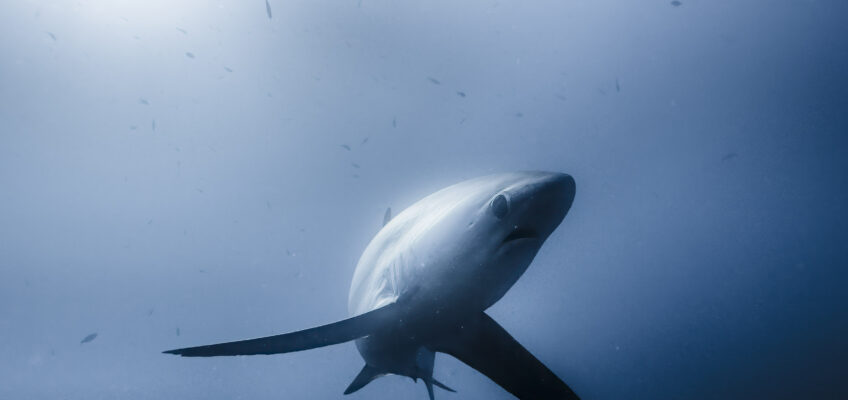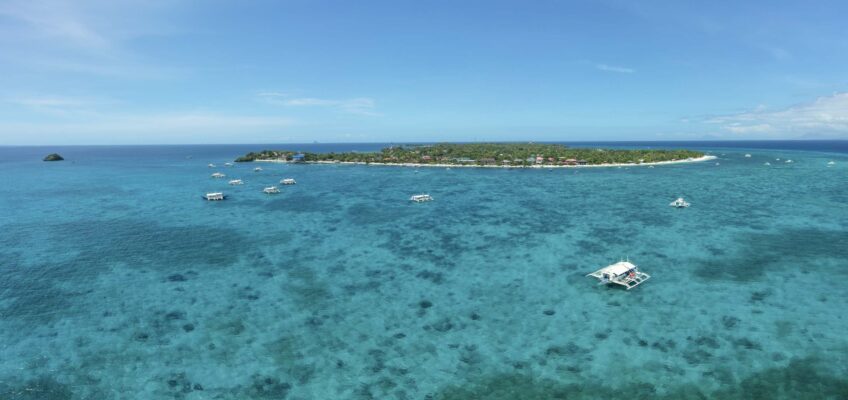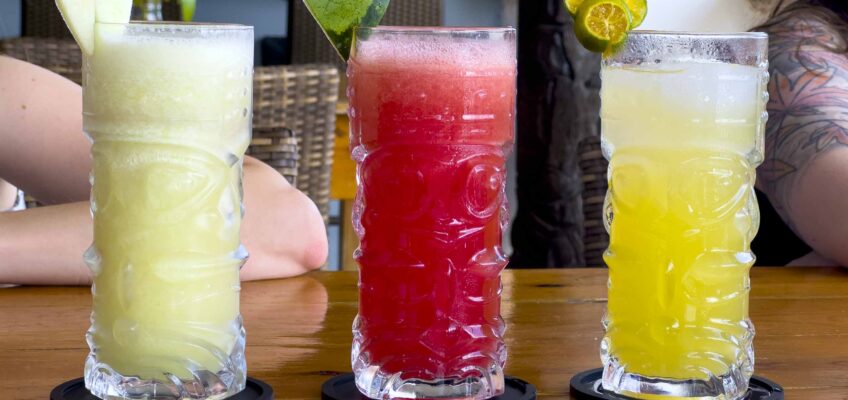Thresher sharks use their tail like a whip to stun prey, what an astounding way to hunt!
I hadn’t been diving for long, just a few weeks into this trip, actually. But the moment I surfaced from my first dives, I was hooked. It was fellow photographer and underwater expert Raphael Studer who first told me about Malapascua. “You have to go,” he said, eyes lighting up, “It’s one of the only places in the world where you can dive with thresher sharks almost every morning.” That was all I needed to hear. So here we were, chasing shadows in the deep before sunrise, hoping the alarm would go off, the boat would hold together, and that the sharks would actually show.


Malapascua: More than a Name
Malapascua is the name most travelers know, but to the locals, it’s Logon, a fishing village with roots long before tourism arrived. Spanish sailors who landed here on December 25th, likely around the 16th century, christened it “Mala Pascua” meaning Bad Christmas after getting stranded during a storm. But life on this tiny island existed long before that. In precolonial times, the community survived through fishing and farming, isolated yet self-sufficient. During World War II, Malapascua suffered under Japanese occupation, and more recently, it was heavily damaged by Typhoon Yolanda (Haiyan) in 2013.
Yet the island always rebuilds.

In the 1990s, divers discovered something remarkable: Monad Shoal, just offshore, where thresher sharks rise from the deep at dawn. That discovery changed everything. By 2002, the shoal became a marine protected area, and in 2015, it was officially declared a shark sanctuary. Local dive shops and NGOs now work with the community to protect these elusive creatures. Without that, I wouldn’t have had the chance to meet a thresher shark face-to-face.
How to Get to Malapascua
There are a few ways to reach Malapascua, and all involve some combination of bus, van, and boat:
- Private transfer: Fastest, most convenient, and definitely the most expensive—especially if you’re only three people, like us. Better value if you’re a group of 5–7.
- Public bus: Cheap, but time-consuming and unreliable. Not ideal when you’re chasing a 4 PM ferry.
- Shared van: The sweet spot—faster and more flexible.
We ended up choosing the private transfer offered by our accommodation to get there, just to be sure we made the ferry on time. It was a bit of a splurge, but it worked like a charm. On our way back, with plenty of time, we opted for a shared boat and van.

Island Life: Two Sides of Paradise
We spent five days at the Little Mermaid Resort and I’m glad we booked the front-row room with a sea view. It was relaxed, low-key, and beautifully quiet. Perfect after long travel days and early dive mornings.
But on day four, we explored the other side of the island and the contrast was stark. Desolate tin-roof houses, families drying fish on roadside racks, and rough dirt alleys. Malapascua might feel like paradise from the beachfront, but life inland tells another story. It’s a reminder: behind every tourist dream lies local reality.

Gear Trouble: My Dive Computer Dilemma
After finishing my Advanced Open Water in Raja Ampat, I was ready to level up with my own dive computer. Unfortunately, we arrived in Malapascua on a Sunday, so all Cebu shops were closed. I bought a Mares Puck Pro from TSD Dive Center instead.
That’s when the problems started.
After the second dive, it froze in boot mode. The staff replaced the battery, fine. Then it crashed again that same evening, no dive involved. They kindly replaced the unit… which also crashed. Twice.
No logs. No working computer. TSD was kind enough to refund me in full, but as of today, I’m still diving without a computer of my own. Lesson learned: buy early, and test before your big trip.

First Dives: A Mixed Start
Our first dive day started slow. Claudia, who joined us from here onward, had booked a refresher course, but it never really happened. We went to a nearby dive site with our local dive guide Hanibal. The first site? A sea urchin wasteland with barely any coral. Disappointing, especially after Raja Ampat.
Thankfully, the second dive was much better: a beautiful soft coral wall with more life and color. Still, the real reason we came was not for corals or clownfish…




Thresher Sharks in Malapascua
5:00 AM. Still dark. We set out to Monad Shoal, the world-famous site for thresher sharks. After an hour’s sail, we dropped down to about 20 meters.
Within minutes, shapes began to emerge from the blue. Five, maybe ten, thresher sharks cruised past us, each more than five meters long. Their long tails moved like silk behind them, silent and controlled. It felt unreal to be in their presence.
Visibility wasn’t perfect, perhaps ten to fifteen meters. And with seventeen dive boats at the site, the number of divers underwater was hard to ignore. Still, Monad Shoal is wide. With a bit of patience, we found a quieter spot where we could take it all in without distraction.

Kimud Shoal: Sand, Coral, and the Tiger I Didn’t Want to Meet
On our third dive, we visited Kimud Shoal, which has a reputation for tiger shark sightings. For me, the threshers were exciting enough. I wasn’t exactly keen to meet a tiger underwater. Still, I joined the dive and loved the scenery: white sand flats, scattered coral heads (bommies), and plenty of macro life to photograph.

Back for More: Second Thresher Shark Dive
The next morning, we went back to Monad. I couldn’t resist. This time, the water was clearer, and there were fewer divers. The sharks came even closer, rising from the deep one after another, gliding past with effortless grace.
Watching them in near silence, it struck me how strange and beautiful these creatures really are. No photo could quite capture the feeling—but I tried anyway.

Back for More: Second Thresher Shark Dive
- Diving: Some boats leave earlier than others. Check in advance to avoid the crowd.
- Dining: Meals are made fresh from scratch. Arrive early, and don’t rush. It’s worth the wait.
- Reality check: Take time to walk beyond the resorts. Malapascua is beautiful, but not everyone shares in its bounty.

Next stop: Tubbataha-Reef and My First Liveaboard
From Malapascua, we head to Puerto Princesa on Palawan. It’s time for my very first Liveaboard, or is it? Stay tuned!
Lots of love and thanks for reading,🫶🏻
Tom

Asia 2025
Chapter 4: Diving in Raja Ampat
Chapter 6: Wild Orangutans in Sumatra: A Jungle Trek to Remember
Chapter 7: Finding Tarsiers in Bohol
Chapter 8: Diving with Thresher Sharks in Malapascua
Chapter 9: Tubbataha Reef Liveaboard
Discover more from ExpediTom
Subscribe to get the latest posts sent to your email.











Leave a Reply